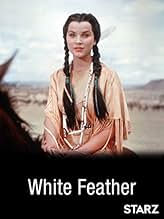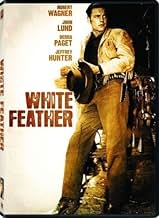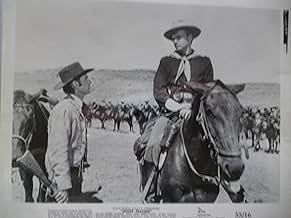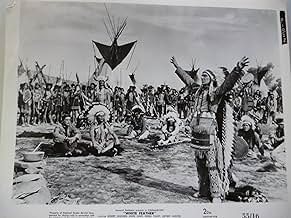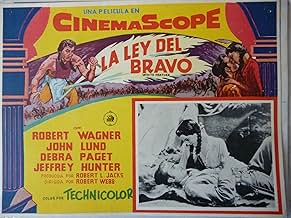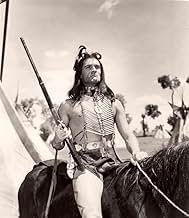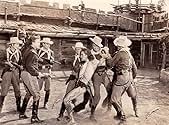Dans le Wyoming de 1877, pendant les négociations de paix entre les Cheyennes et les États-Unis, une Indienne tombe amoureuse d'un géomètre, ce qui provoque la colère de son fiancé Cheyenne.Dans le Wyoming de 1877, pendant les négociations de paix entre les Cheyennes et les États-Unis, une Indienne tombe amoureuse d'un géomètre, ce qui provoque la colère de son fiancé Cheyenne.Dans le Wyoming de 1877, pendant les négociations de paix entre les Cheyennes et les États-Unis, une Indienne tombe amoureuse d'un géomètre, ce qui provoque la colère de son fiancé Cheyenne.
- Réalisation
- Scénario
- Casting principal
- Lt. Ferguson
- (as Noah Beery)
- Indian Chief
- (non crédité)
Avis à la une
Wagner who affirms to colonel John Lund in charge of Fort Laramie that he has no feeling about Indians, makes Indians friends, particularly with two young warriors Little Dog and American Horse...
Complications arise when Chief Broken Hand's daughter Appearing Day (Debra Paget) engaged to American Horse falls in love with Tanner (Wagner) and he with her Tanner's friendship with Little Dog grows slowly but surely It is one of the most enduring traits of the film, having just the right amount of momentum, frustration and humor...
Jeffrey Hunter steals the show with a great performance of the proud warrior Little Dog whose pen does not fit Cheyenne warriors' hand as well as the arrow Little Dog's blood ran hot at the council, gets angry and chooseswith his pal American Horse to meet the troops in battle
Eduard Franz is superb as the venerable Indian chief, Broken Hand, who called the council to tell them that on this day, they have agreed to take the offer of the white man and leave this country Hugh O'Brian is well chosen as Hunter's best friend, American Horse Noah Beery does one of his better work as the obedient cavalry lieutenant
Debra Paget reprises her role as the radiant Indian girl Appearing Day who would be happy in a white man's world We all remember her role as the delicate Indian healer girl Sonseeahray in Delmer Daves' memorable Western "Broken Arrow."
Robert D. Webb captures splendid panoramic shots that site expansive stretches of green fields and blue skies Webb does provide a handful of transcendent moments, the most spellbinding of which is Tanner's participation in honoring his brave friend
One of the few 1950s Westerns to show sympathy towards the Indian plight, White Feather is a well intentioned and well executed movie. It suffers a little from familiarity with Broken Arrow (1950), where Delmer Daves had directed James Stewart and Debra Paget thru a similar script to the one that's now in front of Wagner and Paget; and lets face it-Wagner is no Jimmy Stewart- and Robert Webb is no Delmer Daves-but there's more than enough good here to lift it above many other liberal Westerns.
Away from the endearing and emotive story (and it is as the Cheyenne are forced out of Wyoming by the Federals), the film also boasts high points for the Western fan to gorge upon. It's gorgeously shot in CinemaScope by Ballard, a first class lens-man in the genre, and Friedhofer's score is pulsating, evocative and in tune with the tone of the tale. Also of note is that these Native Americans aren't caricatures or pantomime Indians. They may be being played by white actors (Hunter & Franz do especially good work), but they feel real and come out as the human beings they were. In fact the whole movie looks convincing.
There's some missteps along the way; such as Wagner over acting and having a voice that's sounds out of place in the Wild West, while the romantic angle (Paget is so beautiful here who could not fall in love with her?) does at times threaten to clog up the narrative. But these things don't hurt the film. On the flip side there's the smooth pacing of the piece, it's only when the tense and exciting climax has arrived that you realise how well the slow burn first half was handled. And Webb may well be a second unit director in all but name here, but his construction of the scenes with hundreds of extras is top notch work.
A fine and under seen Western that is based on actual events and doesn't over egg its pudding. 7/10
Casting is adequate, too: apart from the afore-mentioned Hunter (though not exactly convincing as a redskin), we get Robert Wagner as an all-too-young Government agent hero who mediates between the two parties, Debra Paget (in a virtual reprise of her BROKEN ARROW role and who eventually defies her people by eloping with Wagner), John Lund as the experienced Cavalry officer in charge, Eduard Franz as Hunter's dignified chieftain father, Hugh O'Brian (as with Peter Graves in the same director's BENEATH THE 12-MILE REEF [1953], a viewing of which preceded this one, he's the heroine's brash but unloved intended), Virginia Leith as a more mature secondary love interest for Wagner, and Emile Meyer as her racist storekeeper father. By the way, I've just taped the first cinematic adaptation of Ira Levin's thrller A KISS BEFORE DYING (1956) off Cable TV which I noticed shares a remarkable number of cast and crew members with the title under review (not least its hunky stars)!
Being a largely outdoor film and in order to supply the appropriate grandeur, Lucien Ballard's widescreen photography is rather frustratingly limited to long or medium shots which, when screened on a normal-sized TV set, unfortunately leads to a certain detachment on the viewer's part; by the way, in the accompanying poster gallery on the DVD, the fact that patrons would be watching a "Cinemascope" production was deemed a bigger draw than even the stars involved! The film culminates with an unusual sort of showdown as Hunter and O'Brian face an entire cavalry unit (apparently an Indian battle custom which explains the film's title) however, the duo's come-uppance sees the personal intervention of Franz, who's not pleased with their 'brave' gesture; this is then followed by a lengthy (and, I'd even say, unwarranted) scene in which Wagner meticulously prepares Hunter for burial.
The Fox DVD includes quite a nice assortment of extras: these include a reproduction of the original pressbook (filled with amusingly irrelevant ballyhoo), a reasonably comprehensive photo gallery, and a number of trailers for the studio's other catalog entries in the genre (among them the desirable Victor Mature vehicle FURY AT FURNACE CREEK [1948] surprisingly narrated and carrying the personal endorsement of none other than Gregory Peck! and latterday black-and-white potboiler CONVICT STAGE [1965], which I'd never heard of myself and can't fathom why it was even deemed worthy of a DVD release).
The storyline may not be exactly fresh—some Indians wanting to make peace while others don't, plus the standard romantic interest—nonetheless, the individual stories are woven well into the larger conflict. Note too, how the screenplay (based on a true story) takes a generally sympathetic view of the Indians' plight— that is, being forced to move by treaty from their traditional lands. This was during a period when Hollywood was beginning to recognize Indians as human beings instead of convenient targets for repeating rifles.
Of course, an A-production requires a guaranteed box-office, and who better to bring in young folks than a leading heartthrob of the day, Robert Wagner. His rail thin frame may not look like John Wayne, but he still manages to convey the needed authority despite his pretty boy appearance. Also, Hunter remains physically impressive as the conflicted Little Dog.
I guess my only gripe is that everyone, Indians included, looks like they just stepped out of a fashion magazine. I mean the costumes are so squeaky clean and perfectly fit that you'd never guess this is supposed to be the dusty frontier. Anyway, this TCF release remains an underrated cowboy-Indian flick, especially for all its impressive crowd scenes.
(In passing—good touch allowing ambient noises such as barking dogs, squawking birds, and crying kids, to color the treaty signing scene. Usually, Hollywood would remove these as distractions, but here they lend a noisy realistic touch.)
Le saviez-vous
- AnecdotesFirst American movie filmed (in 1954) in Durango, Mexico, because art director Jack Martin Smith liked the soundstages in the city and found the surrounding landscapes to be just what he was looking for.
- GaffesThe Army, at no time during the Indian Wars, used Winchester repeating lever action rifles, as shown.
- Citations
Josh Tanner: Eveything you will see in this movie actually happened, with the exception being the Indians' language. For the purposes of this story, they will speak English so that you can understand them.
- ConnexionsReferenced in Chappaqua (1966)
Meilleurs choix
- How long is White Feather?Alimenté par Alexa
Détails
- Date de sortie
- Pays d’origine
- Langue
- Aussi connu sous le nom de
- La plume blanche
- Lieux de tournage
- Fort Laramie National Historic Site - 965 Gray Rocks Road, Fort Laramie, Wyoming, États-Unis(actual Fort at center of events and activities portrayed)
- Société de production
- Voir plus de crédits d'entreprise sur IMDbPro
Box-office
- Budget
- 1 125 000 $US (estimé)
- Durée1 heure 42 minutes
- Rapport de forme
- 2.55 : 1
Contribuer à cette page



